Modeling and Performance Evaluation of a Context Information-Based Optimized Handover Scheme in 5G Networks
Abstract
:1. Introduction
- The proposed optimized handover scheme is extended and more elaborated from our previous work so a UE with low speed and low rate data traffic can be handed over to a small cell BS, depending on the traffic load condition of neighboring small cell BSs.
- A thorough optimization problem for the proposed handover scheme is formulated, from the aspect of the minimization of the number of handovers and energy consumption of BSs, for the performance analysis based on context information such as RSRP, speed of UE, traffic load, call admission control level, and data type.
- The particle swarm optimization is applied to solve the formulated optimization problem heuristically.
- Extensive numerical examples are obtained through simulation based on the assumption of specific probability distributions of various random variables defined in this paper, and the performance of the proposed scheme is evaluated in detail.
2. An Optimized Handover Based on Context Information
2.1. System Model
2.2. An Optimized Handover Scheme
3. Numerical Examples
4. Conclusions
Acknowledgments
Author Contributions
Conflicts of Interest
References
- Webb, M. GeSI (Global e-Sustainability Initiative). In SMART 2020: Enabling the Low Carbon Economy in the Information Age; The Climate Group: Lambeth, London, 2008; Available online: http://gesi.org/files/Reports/Smart%202020%20report%20in%20English.pdf (accessed on 23 June 2017).
- Fehske, A.; Fettweis, G.; Malmodin, J.; Biczok, G. The global footprint of mobile communications: The ecological and economic perspective. IEEE Commun. Mag. 2011, 49, 55–62. [Google Scholar] [CrossRef]
- Hasan, Z.; Boostanimehr, H.; Bhargava, V.K. Green cellular networks: A survey, some research issues and challenges. IEEE Commun. Surv. Tutor. 2011, 13, 524–540. [Google Scholar] [CrossRef]
- Aleksic, S. Energy, entropy, and exergy in communication networks. Entropy 2013, 15, 4484–4503. [Google Scholar] [CrossRef]
- Chiaraviglio, L.; Ciullo, D.; Meo, M.; Marsan, M.A. Energy-aware UMTS access networks. In Proceedings of the International Symposium on Wireless Personal Multimedia Communications (WPMC), Lapland, Finland, 8–11 September 2008; p. 105. [Google Scholar]
- Marsan, M.A.; Chiaraviglio, L.; Ciullo, D.; Meo, M. Optimal energy savings in cellular access networks. In Proceedings of the IEEE International Conference on Communications Workshops (ICCW), Dresden, Germany, 14–18 June 2009. [Google Scholar]
- Peng, C.; Lee, S.B.; Lu, S.; Luo, H. GreenBSN: Enabling energy-proportional cellular base station network. IEEE Trans. Mob. Comput. 2014, 13, 2537–2551. [Google Scholar] [CrossRef]
- Bousia, A.; Kartsakli, E.; Alonso, L.; Verikoukis, C. Dynamic energy efficient distance-aware base station switch On/Off scheme for LTE-advanced. In Proceedings of the IEEE Global Communications Conference (GLOBECOM), Anaheim, CA, USA, 3–7 December 2012; pp. 1532–1537. [Google Scholar]
- Bousia, A.; Antonopoulos, A.; Alonso, L.; Verikoukis, C. “Green” distance-aware base station sleeping algorithm in LTE-Advanced. In Proceedings of the IEEE International Conference on Communications (ICC), Ottawa, ON, Canada, 10–15 June 2012; pp. 1347–1351. [Google Scholar]
- Chang, C.Y.; Liao, W.; Shiu, D. On the coverage preservation problem in green cellular networks. In Proceedings of the IEEE Global Communications Conference (GLOBECOM), Anaheim, CA, USA, 3–7 December 2012; pp. 3496–3501. [Google Scholar]
- Oh, E.; Son, K.; Krishnamachari, B. Dynamic base station switching-On/Off strategies for green cellular networks. IEEE Trans. Wirel. Commun. 2013, 12, 2126–2136. [Google Scholar] [CrossRef]
- Niu, Z.; Wu, Y.; Gong, J.; Yang, Z. Cell zooming for cost-efficient green cellular networks. IEEE Commun. Mag. 2010, 48, 74–79. [Google Scholar] [CrossRef]
- Niu, Z. Tango: Traffic-aware network planning and green operation. IEEE Wirel. Commun. Mag. 2011, 18, 25–29. [Google Scholar] [CrossRef]
- Ashraf, I.; Boccardi, F.; Ho, L. Sleep mode techniques for small cell deployments. IEEE Commun. Mag. 2011, 49, 72–79. [Google Scholar] [CrossRef]
- Saker, L.; Elayoubi, S.E.; Combes, R.; Chahed, T. Optimal control of wake up mechanisms of femtocells in heterogeneous networks. IEEE J. Sel. Areas Commun. 2012, 30, 664–672. [Google Scholar] [CrossRef]
- Wildemeersch, M.; Quek, T.Q.S.; Slump, C.H.; Rabbachin, A. Cognitive small cell networks: Energy efficiency and trade-offs. IEEE Trans. Commun. 2013, 61, 4016–4029. [Google Scholar] [CrossRef]
- Lee, K.S.; Kim, H.S.; Kim, Y.T.; Kim, B.H. DANCE: Small AP On/Off algorithms in ultra dense wireless network. J. Korean Inst. Commun. Inf. Sci. 2013, 38, 1135–1144. [Google Scholar] [CrossRef]
- Feng, M.; Mao, S.; Jiang, T. BOOST: Base station On-Off switching strategy for energy efficient massive MIMO HetNets. In Proceedings of the 35th Annual IEEE International Conference on Computer Communications (INFOCOM), San Francisco, CA, USA, 10–15 April 2016; pp. 1395–1403. [Google Scholar]
- Cai, S.; Che, Y.; Duan, L.; Wang, J.; Zhou, S.; Zhang, R. Green 5G heterogeneous networks through dynamic small-cell operation. IEEE J. Sel. Areas Commun. 2016, 34, 1103–1115. [Google Scholar] [CrossRef]
- Feng, M.; Mao, S.; Jiang, T. Base station On-Off switching in 5G wireless networks: Approaches and challenges. arXiv, 2017; arXiv:1703.09875. [Google Scholar]
- Liu, C.; Natarajan, B.; Xia, H. Small cell base station sleep strategies for energy efficiency. IEEE Trans. Veh. Technol. 2016, 65, 1652–1661. [Google Scholar] [CrossRef]
- Guo, X.; Niu, Z.; Zhou, S.; Kumar, P.R. Delay-constrained energy-optimal base station sleeping control. IEEE J. Sel. Areas Commun. 2016, 34, 1073–1085. [Google Scholar] [CrossRef]
- Wu, J.; Wong, E.W.M.; Guo, J.; Zukerman, M. Performance analysis of green cellular networks with selective base-station sleeping. Perform. Eval. 2017, 111, 17–36. [Google Scholar] [CrossRef]
- Antonopoulos, A.; Kartsakli, E.; Bousia, A.; Alonso, L.; Verikoukis, C. Energy-efficient infrastructure sharing in multi-operator mobile networks. IEEE Commun. Mag. 2015, 53, 242–249. [Google Scholar] [CrossRef]
- Oikonomakou, M.; Antonopoulos, A.; Alonso, L.; Verikoukis, C. Cooperative base station switching off in multi-operator shared heterogeneous network. In Proceedings of the IEEE Global Communications Conference 2015 (GLOBECOM), San Diego, CA, USA, 6–10 December 2015; pp. 1–6. [Google Scholar]
- Lee, S.; Moon, S.; Yi, Y. On greening cellular networks by sharing base stations: A game-theoretic approach. In Proceedings of the 9th EAI International Conference on Performance Evaluation Methodologies and Tools (VALUETOOLS), Berlin, Germany, 14–16 December 2015; pp. 87–94. [Google Scholar]
- Bousia, A.; Kartsakli, E.; Antonopoulos, A.; Alonso, L.; Verikoukis, C. Multiobjective auction-based switching-off scheme in heterogeneous networks: To bid or not to bid? IEEE Trans. Veh. Technol. 2016, 65, 9168–9180. [Google Scholar] [CrossRef]
- Bousia, A.; Kartsakli, E.; Antonopoulos, A.; Alonso, L.; Verikoukis, C. Game-theoretic infrastructure sharing in multioperator cellular networks. IEEE Trans. Veh. Technol. 2016, 65, 3326–3341. [Google Scholar] [CrossRef]
- Roessler, A.; Schlienz, J.; Merkel, S.; Kottkamp, M. LTE-Advanced (3GPP Rel.12) Technology Introduction; White Paper; Rohde and Schwarz: Munich, Germany, 2014; Available online: http://www.rohde-schwarz-usa.com/rs/324-UVH-477/images/1MA252_WP_LTE_Rel12_1E.pdf?aliId (accessed on 23 June 2017).
- He, G.; Zhang, S.; Chen, Y.; Xu, S. Architecture design and performance evaluation for future green small cell wireless networks. In Proceedings of the 2013 IEEE International Conference on Communications, Budapest, Hungary, 9–13 June 2013; pp. 1178–1182. [Google Scholar]
- Ishii, H.; Kishiyama, Y.; Takahashi, H. A novel architecture for LTE-B: C-plane/U-plane split and phantom cell concept. In Proceedings of the 2012 IEEE Globecom Workshops, Anaheim, CA, USA, 3–7 December 2012; pp. 624–630. [Google Scholar]
- Zhang, S.; Wu, J.; Gong, J.; Zhou, S.; Niu, Z. Energy-optimal probabilistic base station sleeping under a separation network architecture. In Proceedings of the 2014 IEEE Global Communications Conference (GLOBECOM), Austin, TX, USA, 8–12 December 2014. [Google Scholar]
- Wang, Z.; Zhang, W. A separation architecture for achieving energy-efficient cellular networking. IEEE Trans. Wirel. Commun. 2014, 13, 3113–3123. [Google Scholar] [CrossRef]
- Zhang, S.; Gong, J.; Zhou, S.; Niu, Z. How many small cells can be turned off via vertical offloading under a separation architecture? IEEE Trans. Wirel. Commun. 2015, 14, 5440–5453. [Google Scholar] [CrossRef]
- Badri, T.F.Z.; Saadane, R.; Wahbi, M.; Mbarki, S. Call admission control scheme for LTE femtocell-macrocell integrated system. In Proceedings of the 2014 IEEE International Conference on Multimedia Computing and Systems (ICMCS), Marrakech, Morocco, 14–16 April 2014. [Google Scholar]
- Boujelben, M.; Rejeb, S.B.; Tabbane, S. A novel green handover self-optimization algorithm for LTE-A/5G HetNets. In Proceedings of the 2015 International IEEE Wireless Communications and Mobile Computing Conference (IWCMC), Dubrovnik, Croatia, 24–28 August 2015. [Google Scholar]
- Sung, N.W.; Pham, N.T.; Huynh, T.; Hwang, W.J.; You, I.S.; Choo, K.K.R. Prediction-based association control scheme in dense femtocell networks. PLoS ONE 2017, 12, e0174220. [Google Scholar] [CrossRef] [PubMed]
- Kanwal, K.; Safdar, G.A. Reduced early handover for energy saving in LTE networks. IEEE Commun. Lett. 2016, 20, 153–156. [Google Scholar] [CrossRef]
- Roy, A.; Da, S.K.; Misra, A. Exploiting information theory for adaptive mobility and resource management in future cellular networks. IEEE Wirel. Commun. 2004, 11, 58–65. [Google Scholar] [CrossRef]
- Wang, L.; Kofman, D.; Binet, D. Towards a framework of network selection in heterogeneous wireless networks. In Proceedings of the 5th EuroNF Workshop on Wireless & Mobility, Stockholm, Sweden, 23–24 October 2008; pp. 1–6. [Google Scholar]
- Seo, D.Y.; Chung, Y.W. A novel handover scheme based on context information in 5G networks. World J. Wirel. Devices Eng. 2017, 1, 45–50. [Google Scholar] [CrossRef]
- Kennedy, J.; Eberhart, R. Particle swarm optimization. In Proceedings of the IEEE International Conference on Neural Networks, Perth, Australia, 27 November–1 December 1955; Volume 4, pp. 1942–1948. [Google Scholar]
- Zhang, W.; Kwak, K.S.; Feng, C. Network selection algorithm for heterogeneous wireless networks based on multi-objective discrete particle swarm optimization. KSII Trans. Internet Inf. Syst. 2012, 6, 1802–1814. [Google Scholar] [CrossRef]
- You, I.S.; Sharma, V.; Atiquzzaman, M.; Choo, K.K.R. GDTN: Genome-based delay tolerant network formation in heterogeneous 5G using inter-UA collaboration. PLoS ONE 2016, 11, e0167913. [Google Scholar] [CrossRef] [PubMed]
- Shahid, A.; Aslam, S.; Lee, L.G. A decentralized heuristic approach towards resource allocation in femtocell networks. Entropy 2013, 15, 2524–2547. [Google Scholar] [CrossRef]
- Hu, W.; Liang, H.; Peng, C.; Du, B.; Hu, Q. A hybrid chaos-particle swarm optimization algorithm for the vehicle routing problem with time window. Entropy 2013, 15, 1247–1270. [Google Scholar] [CrossRef]
- Alsharif, M.H.; Nordin, R.; Ismail, M. Cell-coverage-area optimization based on particle swarm optimization (PSO) for green macro long-term evolution (LTE) cellular networks. In Bio-Inspired Computation in Telecommunications; Morgan Kaufmann: Waltham, MA, USA, 2015; Chapter 11; pp. 245–262. [Google Scholar]

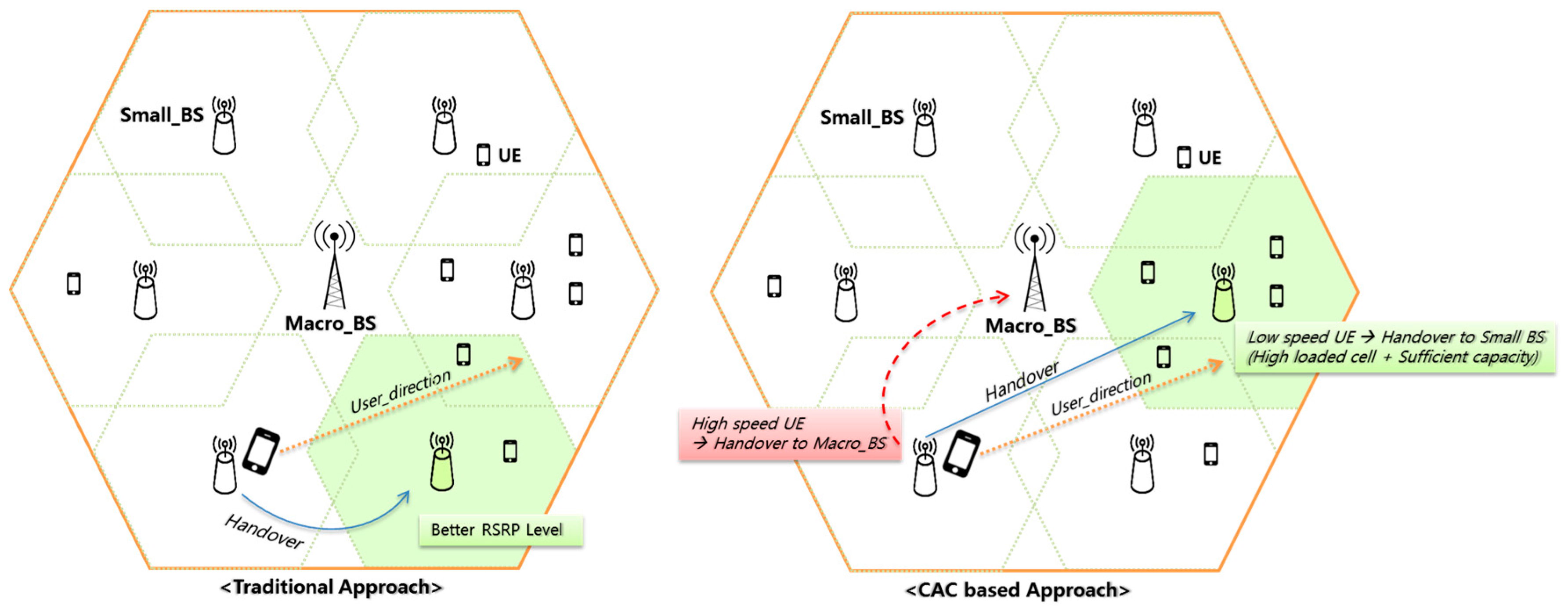
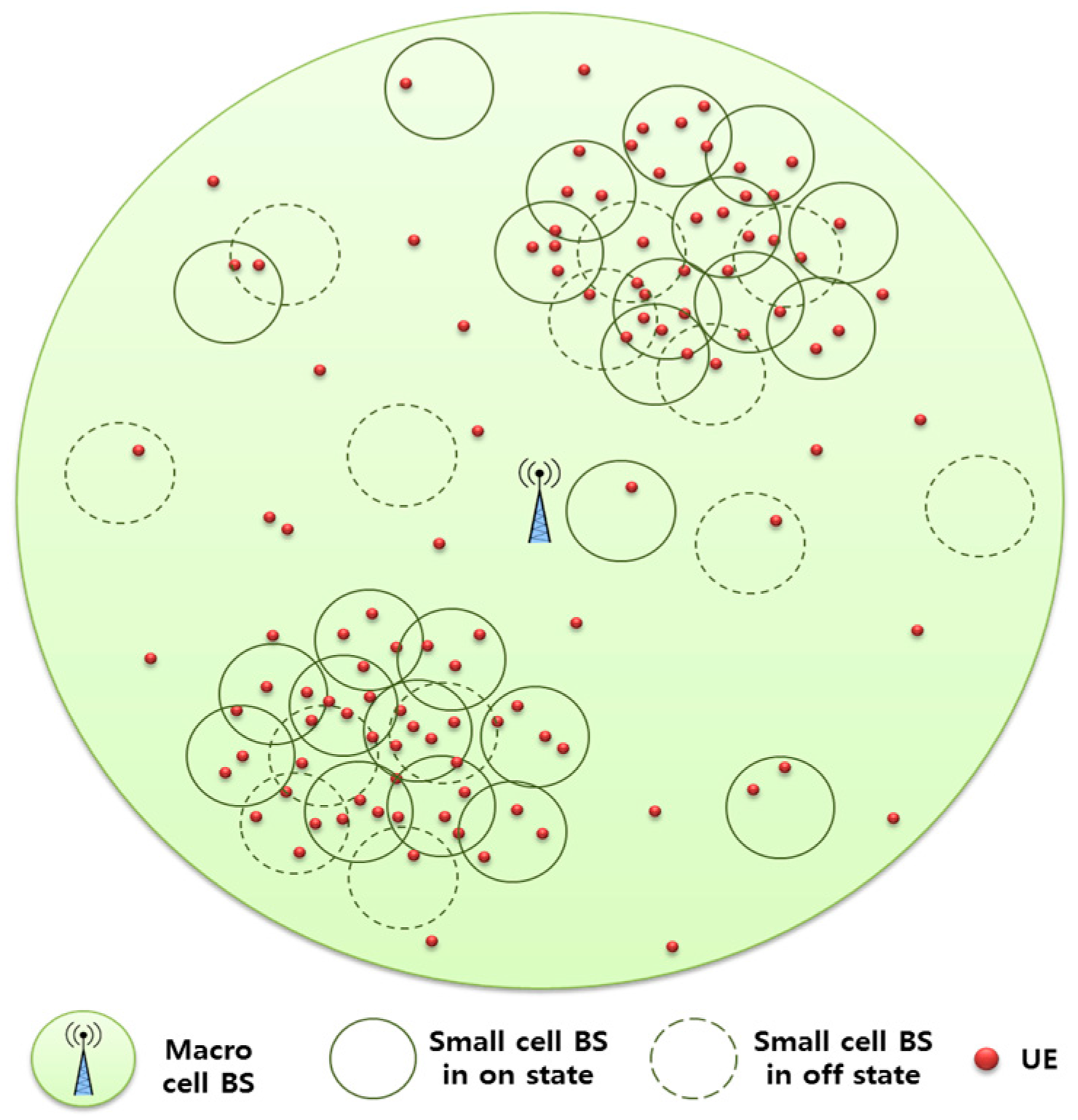
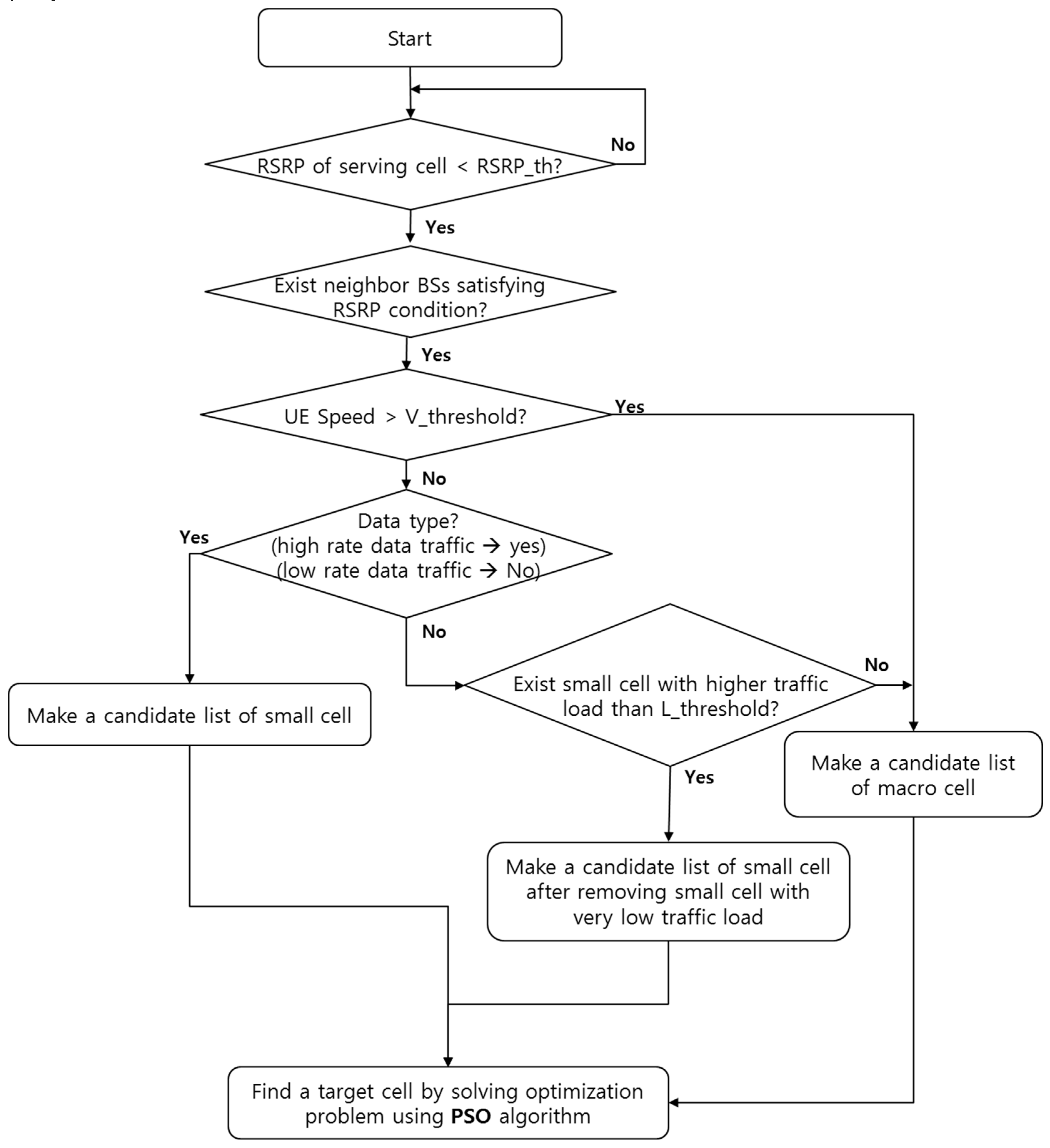

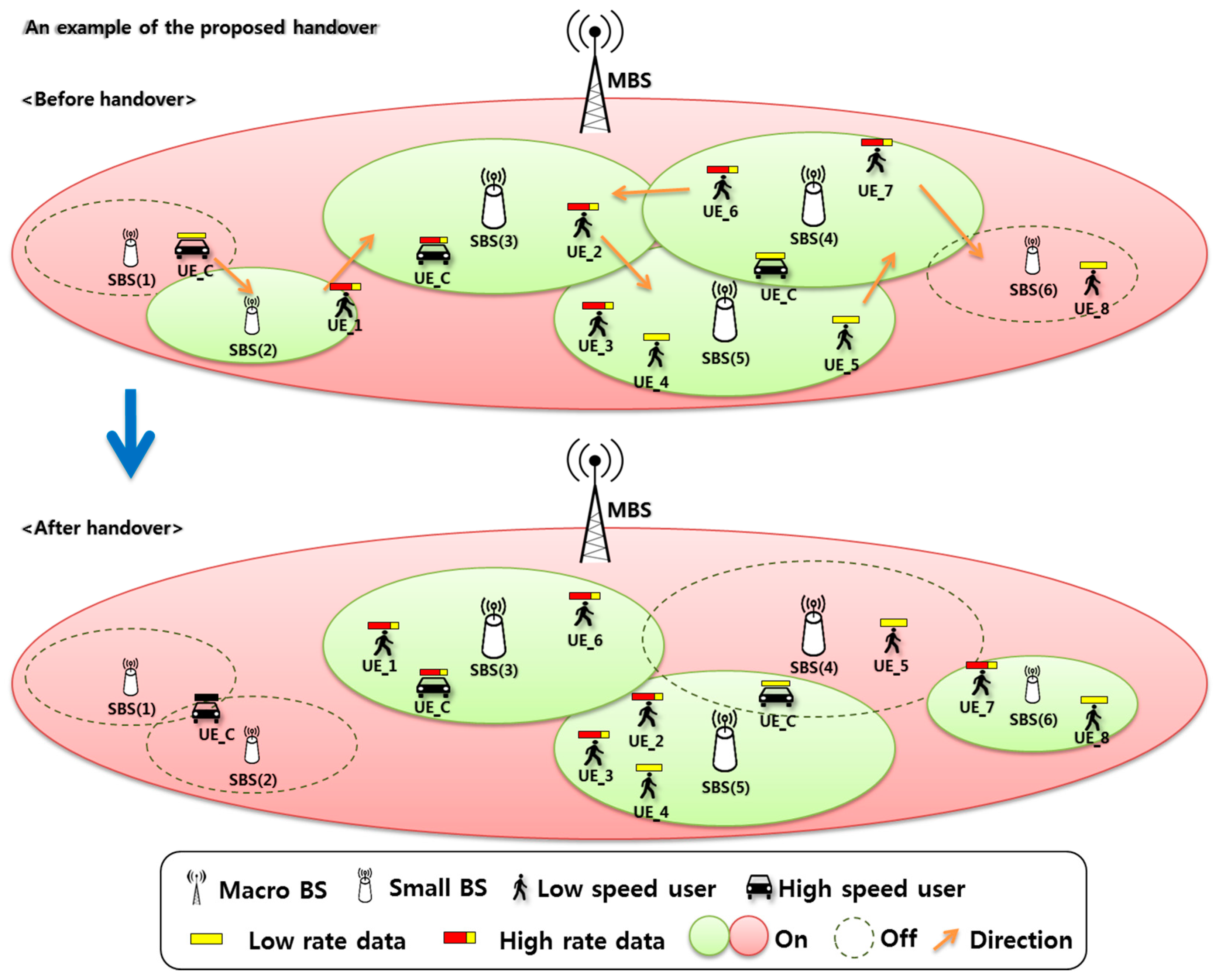
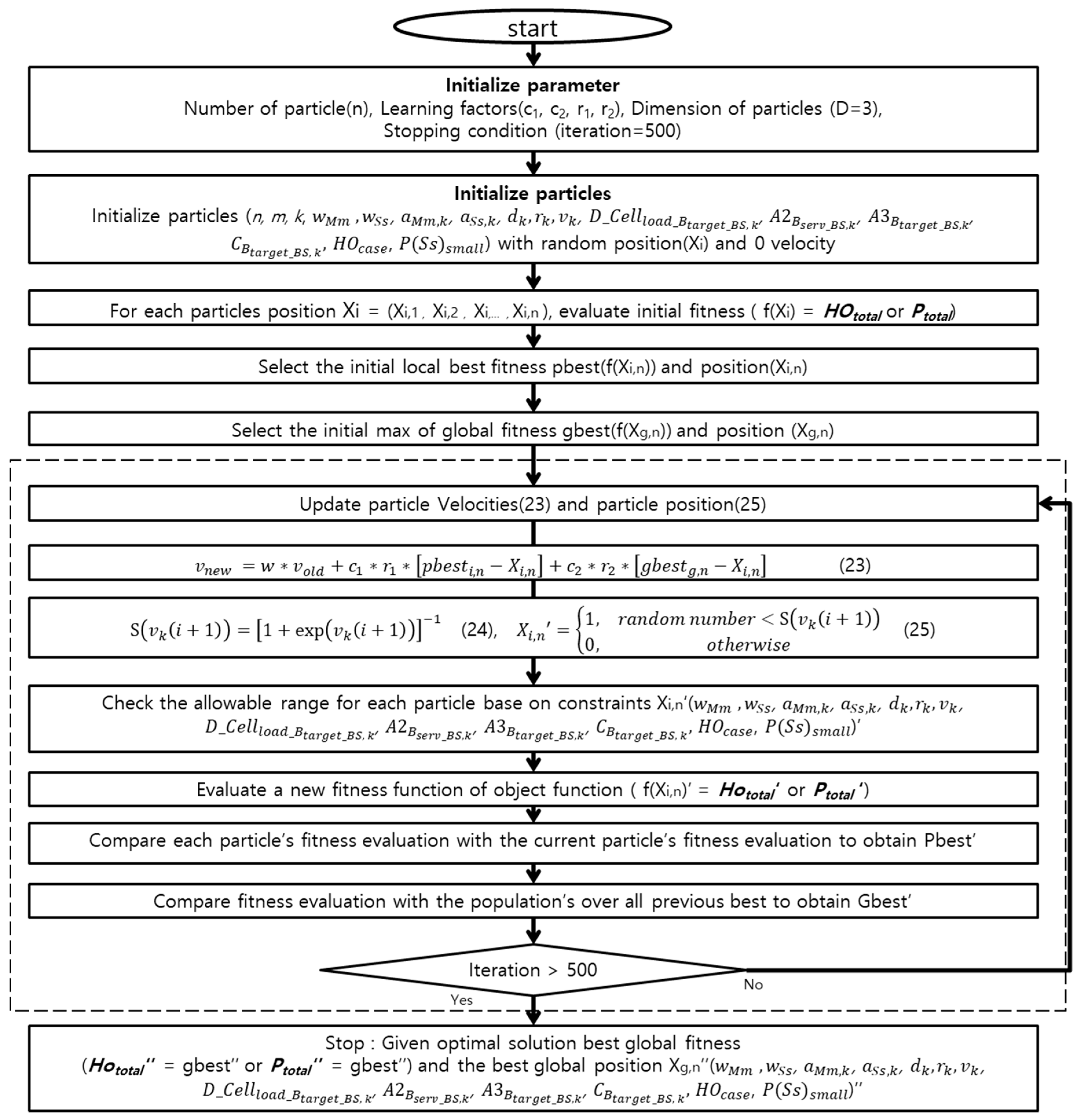
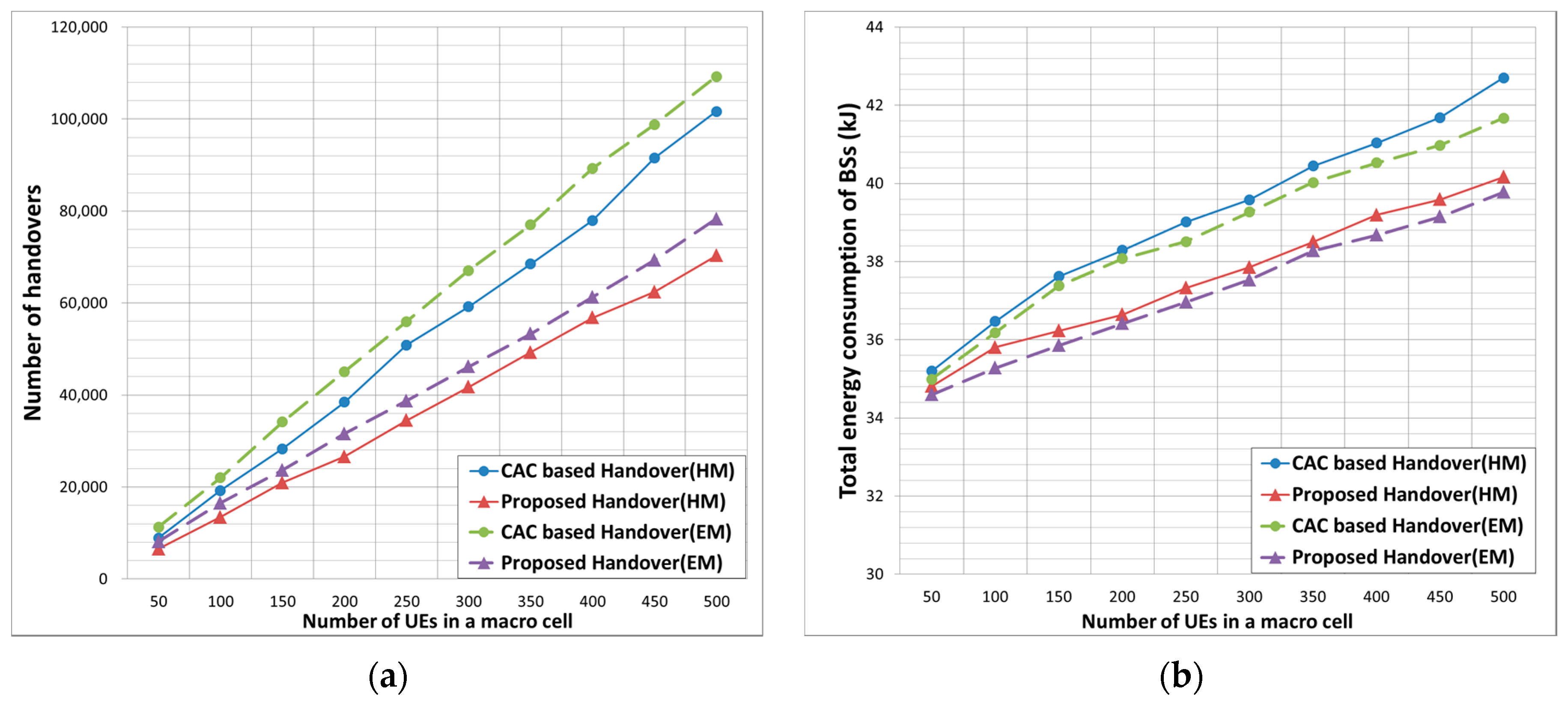
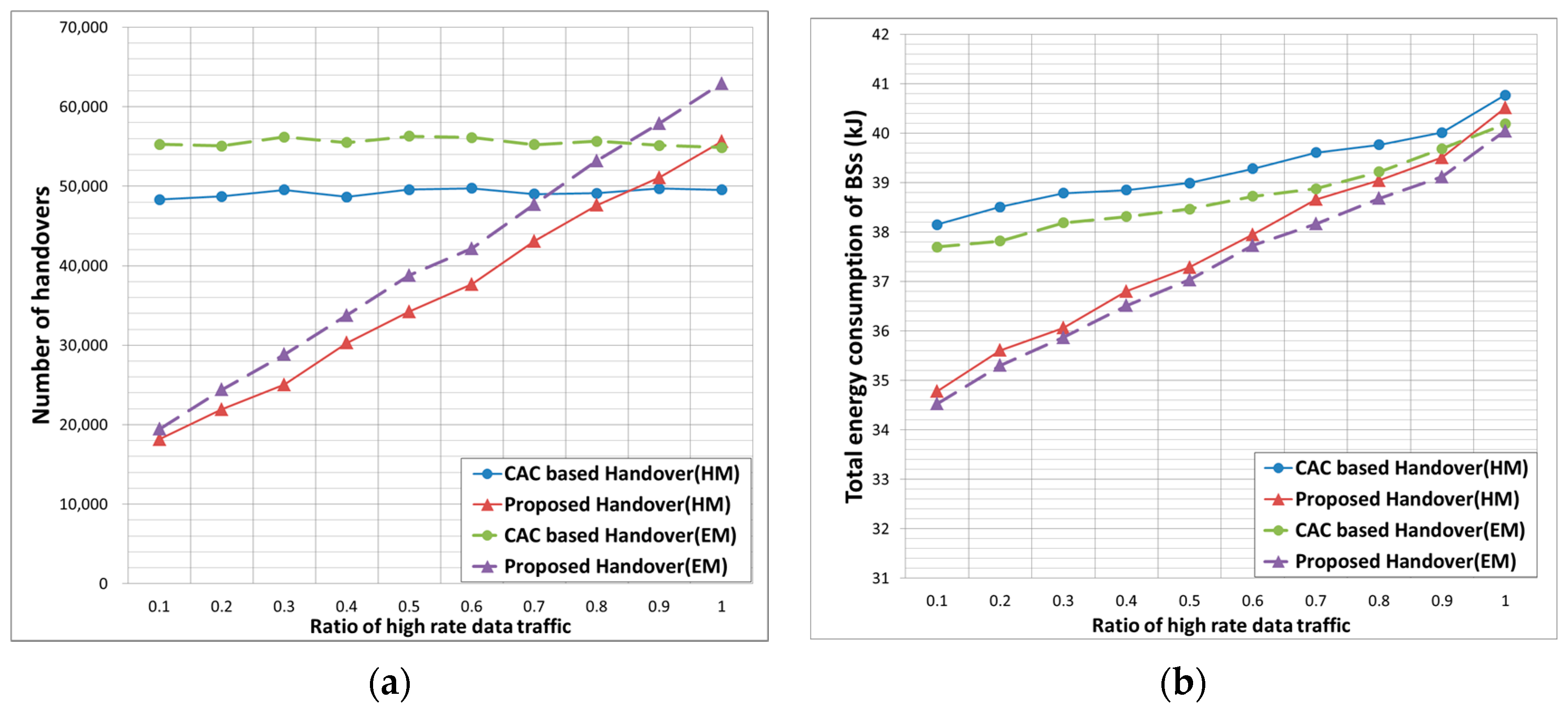
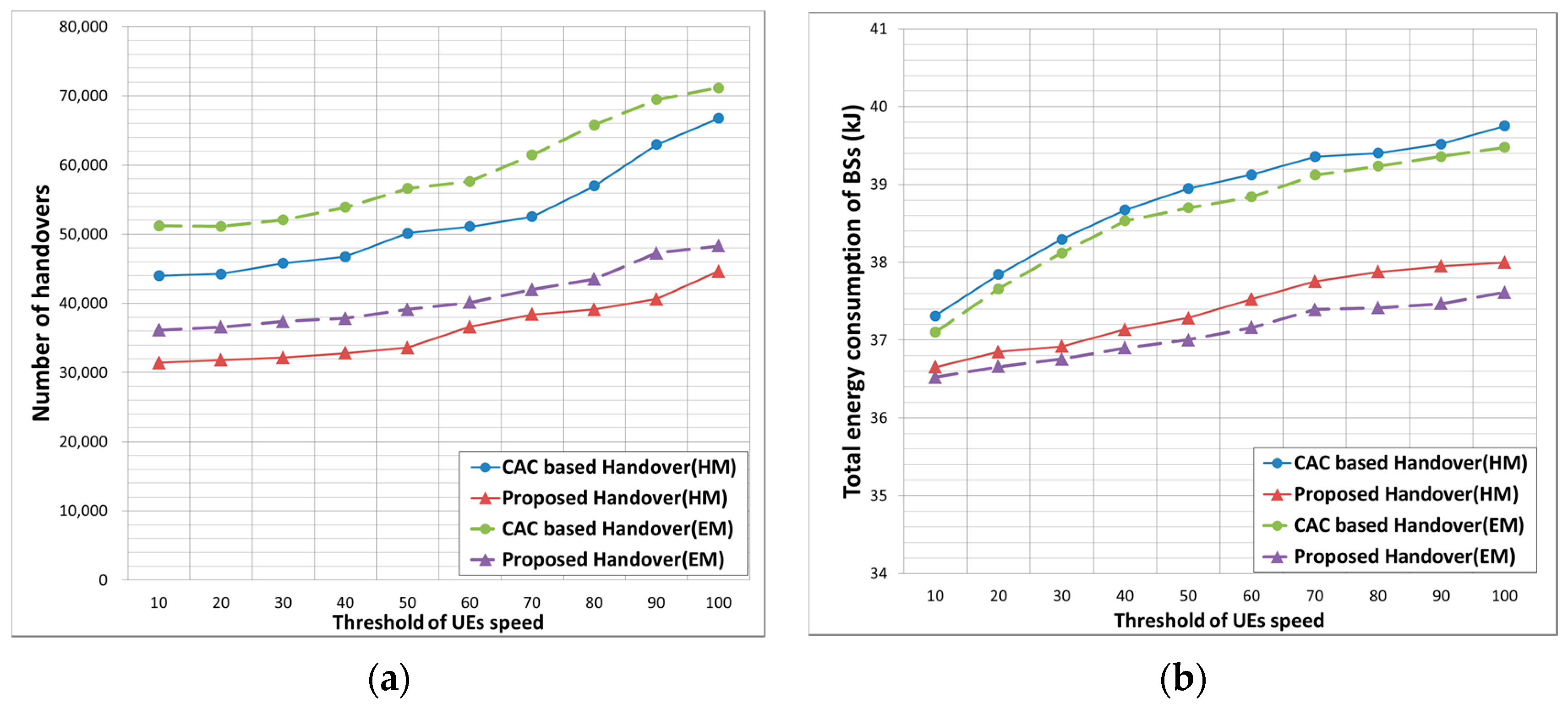
| Value | Description |
|---|---|
| State of a macro cell | |
| State of small cell | |
| Service state of in a macro cell | |
| Service state of in a small cell | |
| Existence of data service requested by | |
| Required data type by | |
| Speed of | |
| Traffic load of a target cell | |
| Maximum power consumption in macro cell with on state | |
| Maximum power consumption in small cell with on state | |
| Static power consumption in macro cell with on state | |
| Static power consumption in small cell with on state | |
| Slope of power consumption in macro cell to transmit UE data | |
| Slope of power consumption in small cell to transmit UE data | |
| Total power consumption of a macro cell | |
| Total power consumption of a small cell | |
| Total power consumption of s-th small cells | |
| Total power consumption of BSs | |
| Reference signal received power of | |
| Reference signal received power of | |
| Condition of Admission control level | |
| C | Total capacity of a cell |
| Total capacity of a macro cell | |
| Total capcity of a small cell | |
| C’ | Actual capacity needed for an active user |
| Requested capacity by a handover call | |
| Requested capcity by a handover call having high rate data service | |
| Requested capcity by a handover call having low rate data service | |
| Number of users requiring high rate data service | |
| Number of users requiring low rate data service | |
| Percentage of cell capacity reserved for handover calls | |
| L_threshold | Threshold of supposing cell has low traffic loads |
| V_threshold | Threshold of user speed having high and low speed |
| The case of comming handover | |
| Total number of handovers |
| Cases | Description |
|---|---|
| case 1 | A UE serviced by a macro cell currently handovers to another macro cell |
| case 2 | A UE serviced by a macro cell currently handovers to a small cell |
| case 3 | A UE serviced by a small cell currently handovers to a macro cell |
| case 4 | A UE service by a small cell currently handovers to another small cell |
| Parameter | Value |
|---|---|
| Number of small cells | 50 |
| Number of UEs | 250 |
| Radius of a macro cell | 1000 m |
| Radius of a small cell | 50 m |
| transmit power of a macro cell | 46 dBm |
| transmit power of a small cell | 25 dBm |
| RSRPth | −13.98 dBm |
| 780 W | |
| 21.6 W | |
| 540 W | |
| 5.4 W | |
| Capacity of a macro cell | 500 |
| Capacity of a small cell | 25 |
| Creq_low | 0.05 |
| Creq_high | 1 |
| THHO | 0.7 |
| Ratio of high rate data traffic | 0.5 |
| v_threshold | 50 km/h |
| v_max | 100 km/h |
| L_threshold | 0.1 |
| PSO Iteration | 500 |
| PSO Swarm Size | 3 |
| c1 | 0.5 |
| c2 | 0.5 |
| r1 | 0.5 |
| r2 | 0.5 |
© 2017 by the authors. Licensee MDPI, Basel, Switzerland. This article is an open access article distributed under the terms and conditions of the Creative Commons Attribution (CC BY) license (http://creativecommons.org/licenses/by/4.0/).
Share and Cite
Seo, D.Y.; Chung, Y.W. Modeling and Performance Evaluation of a Context Information-Based Optimized Handover Scheme in 5G Networks. Entropy 2017, 19, 329. https://doi.org/10.3390/e19070329
Seo DY, Chung YW. Modeling and Performance Evaluation of a Context Information-Based Optimized Handover Scheme in 5G Networks. Entropy. 2017; 19(7):329. https://doi.org/10.3390/e19070329
Chicago/Turabian StyleSeo, Dong Yeong, and Yun Won Chung. 2017. "Modeling and Performance Evaluation of a Context Information-Based Optimized Handover Scheme in 5G Networks" Entropy 19, no. 7: 329. https://doi.org/10.3390/e19070329




